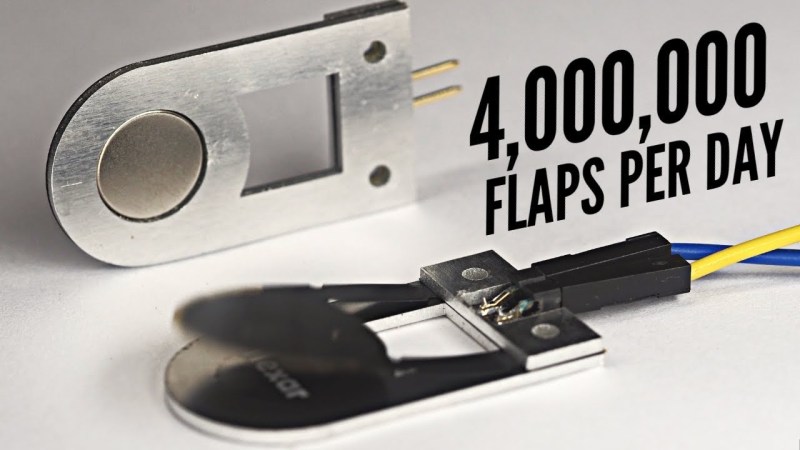Flexible PCBs are super-useful things, but they can have a limited fatigue life. [Carl Bugeja] has been using them to create flexible actuators, though, and he’s getting an amazing 100,000,000 cycles out of them after some rigorous development.
[Carl] explores all manner of optimizations to his flippy actuators in the video. He tried making them oscillate faster by putting a hole in the middle to reduce drag. Other tricks include getting the arm thickness just right, and experimenting with rigidity through adding or removing sections of soldermask.
Fundamentally, though, he learned the key to longevity laid in the copper traces on the flex PCBs themselves. After enough flexural cycles, the traces would fail, killing the actuator. He experimented with a variety of solutions, eventually devleoping a ruggedized two-arm version of his actuator. Twenty samples were put to the test, oscillating at 25 Hz for two weeks straight. All samples survived the test, in which they were put through around 107,820,000 cycles.
[Carl] has put in plenty of hard work on this project, and his actuators have come a long way since we saw them last. He hopes to use the better actuators to improve his FlexLED display. Video after the break.
















With proper magl-ev bearing and powerful enough solenoids it should be possible to create a toilet seat that can toggle between “open” and “closed” states with frequency of 100 kHz or more. It may create a bit of breeze in cloaca though.
A breeze in my cloaca?
More likely than you think. Toilet seat buzzing at 20 Hz would make one hell of a subwoofer. At 100 kHz it could clean the bowl and probably heat an entire house.
Thinking outsde the box. Loeve it!
You’re not thinking with your marketing brain. It’s an ultrasonic bidet!
No need to wipe with the all new Ronco Ultra-Bidet. It slices, it dices, it will blast away any mess with the power of sonic vibrations. Never buy toilet paper again! Call now and we’ll ship you the sonic bladder stimulator. FOR FREE!!! Why fuss with a catheter when you can manually void your bladder with the push of a button!
*Use only as directed, Ultra-Bidet may deglove all soft tissues from bone. If you can see your pelvic girdle, stop using it immediately and… well, bleed to death.
Erm, I make 25Hz for 2 weeks to be 30,240,000 cycles.
I guess it was multiplied by the number of flappers.
It doesn’t add up like that.
Yes, if you watch the video he shows his math– he is indeed calculating that all of them racked up 100million flaps between them.
Which is, erm, an *interesting* choice of durability metric. Borderline “lying with numbers” stuff…
the test went on for more than 4 weeks and as explained in the video the cycles includes both polarities
If you divide it by the number of test items, you get MTBF
you’d need to multiply by 2 because his 100 million is flaps rather than cycles, but it’s still short. the math only works if it’s 25 days rather than 14. the closest the video comes to saying the two week figure is “more than two weeks” but if it was actually 25 day I’d think he would have said “more than three weeks” so I’m not sure who’s the source of the inacuracy.
before the 2 week test (running at 25Hz), they had already been powered for 2 other weeks at 16Hz
I wonder if you could put another stationary coil beneath it to induce current in the flexible PCB, thereby preventing the need for copper traces going through the flexure? Bet that would last a nice long time.
Maybe make one with on opposite “twist” coil for the base part instead of needing the magnet?
i was trying to come up with a design that was two coils which opposite polarity which would push each other apart. i wanted something without a heavy magnet because i wanted to make rc paper airplanes, so weight was undesirable. my experiences with magnet wire were less than ideal, a capton coil is the way to go. im not sure i need the speed or reliability of this flapper though. i just need to move a control surface with a pwm signal, with static forces rather than a steady oscilation. twin motors is also an option, but thats weight id like to avoid.
Have you considered Eddy current losses in the aluminium? Might be worth adding some slots to the alumimium part or seeing what the effect of other materials is. May not affect the frequency much but efficiency might improve.
Has he tried to “snake” the traces on the arm to get the strain off of the copper trace?
id just include multiple redundant conductors connected together at the ends. if one breaks the rest can carry the current.
Now we can have dragonfly drones with real flapping wings! I’m in!
the cia has had dragonfly drones since the ’70s. they probibly used similar actuators.
Ok… So what do we do with these?